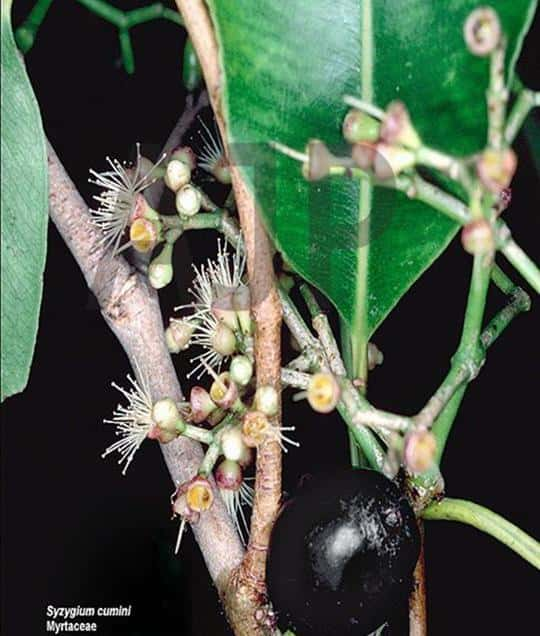Jambu

Botanical Name : Syzygium cuminii
Family : Myrtaceae
Introduction :
Jambu is mentioned in Vedià literature & rituals. Fruit/seed is mainly used in the management of diabetes & bark is used for diarrhoeal disorders.
Names in different Indian languages :
Hindi : Jamun
Telugu : Neredu
Tamil : Naval
English : Jaman, Black plum
Punjabi : Jamalu
Kanada : Nerale
Malayalam : naval
Bengali : Kala jam
Sanskrit : Jambuh
Unani : Jaamun
Synonyms :
Kökilesta, Pikabhaksa, Phaleñdra, Jãmbava, Jambu, Mahaaphalaa,
Surabhipatra
Syzygium jambolanum (Lam.) DC.
Eugenia jambolana Lam
Varieties & adulterants – (CV – controversy, AD – adulterants) :
1. Kãka Jambu (Jambu- Eugenia jambolana ,Syzygium cumini)
2. Jala Jambu (Ksudra Jambu , Bhümi Jambu,Nadi Jambu. – heyneana Wall./E. operculata Roxb.)
3. Rãja Jambu- Eugenia jambos L. (Syzygium jambos (L.) Alston
Morphology :
It is a moderate-sized, glabrous tree about 18-20 m. height.
Leaves- coriaceous, shining, entire, oval, oval-oblong or lanceolate-oblong, long-acuminate, lateral nerves numerous, parallel, confluent near the margin.
Flowers- greenish, tetramerous, in 3-flowered cymes, arranged. in broad trichotomous panicles. Calyx-tube funnel-shaped.
Fruit- berry, oblong or subglobose, purple or black, succulent, smooth when ripe.
Chemical Constituents :
Seed contains a glucoside – jamboline, ellagic acid, yellow essential oil, chlorophyll, resin, gallic acid, albssñrin etc.Bark has 12% gum.
Fruits eugenia triterpenoids A & B, oleanolic acid, malic acid, glucose, fructose, gallic acid
Stem bark & root- Kaempferol , myricetin, quercetin
Leaves- citric, oxalic and glycollic acids; glucose, leucine, sitosterol, dihydromyricetin etc.
anthocyanins , citric, malic ,gallic acids, and tannins
Properties :
Rasa -Kasäya, Madhura, Amla
Guna -Laghu, Rüksa
Virya- Sita
Vipãka -Katu
Karma : Vãtavardhaka, Kapha-pitta hara, Grãhi
Astringent, digestive, anthelmintic, febrifuge, anti bacterial, stomachic, carminative, diuretic.
Indications :
Madhumeha, Atisara, Chardi, Raktapitta, Dãha, Vrana
leucorrhoea, fever, skin disease, diabetes(seed), ulcer
Part Used :
Fruit, leaf, stem bark
Dosage :
Fresh juice 25-50 ml; powder 4-6 g.
External Uses :
Astringent, refrigerant and cures skin disorders. The bark powder is sprinkled in bleeding disorder: Fruit pulp mixed with sesame oil is applied in burning condition, in sannipat jwara (fever caused by all the three doshas) associated with burning. The oil boiled with the leaves is used face application.
Internal Uses :
Digestive system: Its fruit is an appetizer, digestive and liver stimulant. liver function associated with diabetes is improved by seed powder. It is also an astringent. Leaves are anathematic while bark is astringent.Excessive use fruits causes constipation. The fruits and fruit juice are effective in disorders like loss of appetite, indigestion, pain and dysentery.
Circulatory system : Haemostatic. Leaf juice is used in haemorrhagic disorders. Jambul seeds are used in menorrhagia and diarrhoea
Urinary system : The frill and seed powder along with milk helps in glucose metabolism in the liver, due to which blood and urine sugar levels become low causing hypoglycemia. Fruit and seed powder are the best medicines in ikshumeha and udakameha.
Srotogamitva :
Dosha Kaphapittaghna, vatavardhak.
Dhatu : Meda and majja (diabetes mellitus),
Mala : Mutra, purisha (astringent).
Jambu is the, topmost vatavardhak medicine,
Important Yogas or Formulations :
Jambvasava, Jambvädi ghrta, Jambvãdi taila
Important research work going on :
(1) Anti-diabetic property
(2) Anorexigenic activity
(3) Hypoglycaemic activity
(4) anti-inflammatory
(5) treatment of diarrhoea and dysentery
(6) antipyretic activities





